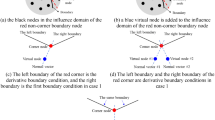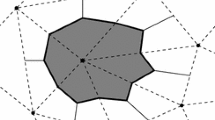Abstract
We present a velocity-oriented discrete analog of the partial differential equations governing porous media flow: the edge-based face element method. Conventional finite element techniques calculate pressures in the nodes of the grid. However, such methods do not satisfy the requirement of flux continuity at the faces. In contrast, the edge-based method calculates vector potentials along the edges, leading to continuity of fluxes. The method is algebraically equivalent with the popular block-centered finite difference method and with the mixed-hybrid finite element method, but is algorithmically different and has the same robustness as the more conventional node-based velocity-oriented method. The numerical examples are computed analytically and may, therefore, be considered as an 'heuristic proof' of the theory and its practical applicability for reservoir engineering and geohydrology.
Similar content being viewed by others
References
Aziz, K. and Settari, A.: 1979, Petroleum Reservoir Simulation, Applied Science Publishers Ltd., London.
Barton, M. L. and Cendes, Z. J.: 1987, New vector finite elements for three-dimensional magnetic field computation, J. Appl. Phys. 61(8), 3919-3921.
Bear, J.: 1972, Dynamics of Fluids in Porous Media, Dover Publications, Inc., New York.
Bossavit, A.: 1998, Computational Electromagnetism, Academic Press, San Diego.
Bossavit, A.: 2001, Generalized finite differences in computational electromagnetism, Prog. Electromagnet. Res. 32, 45-64 (Also cf. http://www.icm.edu.pl/edukacja/mat.php).
Bossavit, A.: 2003, Mixed-hybrid methods in magnetostatics, IEEE T. Magn. (in press).
Brand, L.: 1947, Vector and Tensor Analysis, John Wiley, New York.
Chavent, G. and Jaffré, J.: 1986, Mathematical Models and Finite Elements for Reservoir Simulation, North-Holland Publishing Company, Amsterdam.
Gerritsen, B. H.M.: 2001, Using Weighted Alpha Complexes in Subsurface Modelling, DUP Science, Delft.
Henle, M.: 1979, A Combinatorial Introduction to Topology, Dover Publications, Inc., New York.
Kaasschieter, E. F.: 1988, Preconditioned conjugate gradients for solving singular systems, J. Comput. Appl. Math. 24, 265-275.
Kaasschieter, E. F. and Huijben, A. J. M.: 1992, Mixed-hybrid finite elements and streamline computations for the potential flow problem, Numer. Meth. Part. D. E. 8, 221-226.
Kotiuga, P. R.: 1991, Clebsch potentials and the visualization of three-dimensional solenoidal vector fields, IEEE T. Magn. 27(5), 3986-3989.
Morse, Ph. M. and Feshbach, H.: 1953, Methods of Theoretical Physics, McGraw-Hill, New York.
Nawalany, M.: 1986a, Numerical model for the transport velocity representation of groundwater flow, in: VIth Int. Conf. on Finite Elements in Water Resources, Lisbon.
Nawalany, M.: 1986b, Environmental applications of the transport velocity representation for groundwater flow, in: Envirosoft' 86, Los Angeles.
Nawalany, M.: 1990, Regional vs. local computations of groundwater flow, in: VIIIth Int. Conf. on Computational Methods in Water Resources, Venice.
Nawalany, M.: 1992, Decoupling the velocity oriented groundwater flow equations for the third type boundary conditions, in: IXth Int. Conf. on Computational Methods in Water Resources, Denver.
Parker, J. W., Ferraro, R. D. and Liewer, P. C.: 1993, Comparing 3D finite element formulations modeling scattering from a conducting sphere, IEEE T. Magn. 29(2), 1646-1649.
Strang, G. and Fix, G.: 1973, An Analysis of the Finite Element Method, Prentice-Hall, Inc., Englewood Cliffs, NJ.
Trykozko, A., Zijl, W. and Bossavit, A.: 2001, Nodal and mixed finite elements for the numerical homogenization of 3D permeability, Computat. Geosci. 5, 61-84.
Weiser, A. and Wheeler, M. F.: 1988, On convergence of block-centered finite differences for elliptic problems, SIAM J. Numer. Anal. 25, 351-357.
Zijl, W.: 1983, Finite element methods based on a transport velocity representation for groundwater motion, Water Resour. Res. 20(1), 137-145.
Zijl, W.: 1986, Numerical simulations based on stream functions and velocities in three-dimensional groundwater flow, J. Hydrol. 85, 459-465.
Zijl, W.: 1993, Scale Analysis in Groundwater Hydrology, VUB-Hydrology Series No. 24, Laboratory of Hydrology, VUB, Pleinlaan 2, B-1050 Brussels.
Zijl, W.: 1999, Scale aspects of groundwater flow and transport systems, Hydrogeol. J. 7, 139-150.
Zijl, W. and Nawalany, M.: 1993, Natural Groundwater Flow, Lewis Publishers/CRC Press, Boca Raton, FL.
Zijl, W. and Trykozko, A.: 2001, Numerical homogenization of the absolute permeability using the conformal-nodal and mixed-hybrid finite element method, Transport Porous Med. 44(1), 33-62.
Zijl, W. and Trykozko, A.: 2002, Numerical homogenization of two-phase flow in porous media, Computat. Geosci. 6, 49-71.
Author information
Authors and Affiliations
Corresponding author
Rights and permissions
About this article
Cite this article
Zijl, W., Nawalany, M. The Edge-Based Face Element Method for 3D-Stream Function and Flux Calculations in Porous Media Flow. Transport in Porous Media 55, 361–382 (2004). https://doi.org/10.1023/B:TIPM.0000013258.79763.a2
Issue Date:
DOI: https://doi.org/10.1023/B:TIPM.0000013258.79763.a2




